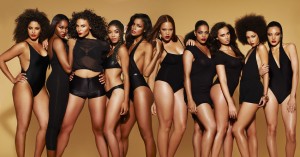(ThyBlackMan.com) The Council of Fashion Designers of America, issued a statement declaring, “the most powerful message is one of diversity.” Yet, year after year the amount of black models showcased in editorials continues to remain alarmingly low. So why should it matter that black models are absent in editorials and on the runways? The answer is simple; fashion shapes the public’s desires. It both creates and feeds a need to live beyond one’s current station. It serves as a model for the “good life,” and designates who is and by absence who is not able to achieve it.
The absence of black models is not covert, it’s glaringly obvious. We do not live in a purely white society, so why is it that the overwhelming percentage of models that grace the runways and editorials in magazines are white? Who is to blame for the inconsistency? Agencies simply react to the demand needs of designers who serve as their primary source of income, not editorials. Since the beginning of the Obama administration the percentage of black models being booked for major advertisements has slowly, but steadily increased, thereby incentivizing agencies to retain more black models.
more black models.
Yet, this increase in the amount of black models held by agencies has not translated into more black models in editorials; in fact, the amount of black models in editorials has actually declined since Obama’s inauguration. So the question then becomes what is motivating fashion editors to exclude black models from the pages of their magazines? Is the public which they serve against seeing black models in editorials, are the editors simply racist, or is there another more covert reasoning?
It has been said by many within the fashion industry that black models don’t sell. Yet, Vogue Italy’s Black Issue, featuring only Black models on the cover and in its editorials is the only issue of Vogue to ever be issued a reprint to satisfy demands after selling out the first run. Furthermore, Blacks exhibit some of the largest consumption rates when it comes to fashion and beauty merchandise of any race.
This fact makes it difficult to argue that Black models are absent due to a lack of demand on the behalf of fashion consumers many of whom are black and would love to see themselves represented in the advertisements for the products they purchase. While seeing a reflection of one’s own race within the pages of fashion magazines leads to aspiration for the lifestyle, what does realizing the absence of the reflection of one’s race in fashion magazines incite?
In 2010 Margaret Beale Spencer re-created the groundbreaking black doll vs. white doll test of the 1940’s. Her results showed a large bias by both white and black children towards lighter skinned dolls, declaring them not only more beautiful but also associated them with having more positive characteristics. These results are especially disconcerting as psychologist have proven that biases developed early on in life typically persist through adulthood. Furthermore, these biases are likely to be denied when confronted by those who have them. Fashion and advertising is not only affecting Black adults, leading to skin whitening and dangerous and painful hair treatments, but also affecting Black children. Who infer from their absence in fashion editorials and advertisements that the good life can only be obtained if they themselves become white or as close to it as possible.
Staff Writer; Jeremy Bamidele
This young brother is a former faculty member at Rancho Santiago Community College in California and currently lives in Philadelphia, Pennsylvania where he is completing Graduate School at the University of Pennsylvania. He can be reached at jbami@sas.upenn.edu.




















White-owned agencies nor magazines aren’t obligated to hire every black woman (or man) who desires to be a model. White-owned anything have the right to hire whomever they want on the cover or the pages inside magazines. Of course, they are gonna hire their own. Blacks got a problem with that? Oh, well.
Black-owned magazines, designers, etc ARE obligated to hire black models. But instead, blacks wanna practice diversity. Seems as though blacks looking for modeling jobs face more competition with non-blacks working for black agencies and designers. Blacks will hire more non-blacks than their own. I know for a fact that there’s more than enough “diversity” among black people. Different shades, sizes, weight, heights, appearances, and ages.
What does Obama becoming president have to do with this subject? He’s not the boss of any modeling agency. And he damn sure can’t demand anyone to hire black people.
Think? I think we as Black People and Women, should put your clothe on, take the focus off your outward appearance, put your gloves on and get to WORK.! The opportunities are passing you by while you focus on your weakness and forget about your strength and what you were destine to do with your mind that you continue to waste on things that do not prosper, glorify God, or help your community!
I urge you to stop and review, consider and join NOW ! for the time is coming where you will once again be LEFT BEHIND ON THE BACK BURNER WHILE EVERYONE ELSE PROSPERS!
WAKE UP. WE HAVE REDUCED THE START UP FEE FROM $700 TO $129.00 TO HELP LOW INCOME, BROKE, BUSTED, PEOPLE OF THE BLACK AND SPANISH COMMUNITY GET IN!!!!
GO THERE NOW! http://WWW.MARKETAMERICA.COM/PBARROW REFERRAL BUSINESS EMAIL MEETUPTEAM@GMAIL.COM IF YOU YET CANNOT AFFORD $129.00 GET ON THE FREEE SITE !!! http://WWW.SHOPMAGLOBAL.COM REFERANCE EMAIL NOT MY NAME MEETUPTEAM@GMAIL.COM I WILL COACH YOU SO THAT YOU WILL BUILD THE $129.00 TO GET IN. CALL/TEXT ME 516 943 2563 . YOU MUST BE COACHABLE, YOU MUST BE HONEST, THIS IS NOT A GAME AND WE DO NOT CARRY YOUR BAGS, YOU MUST BE SELF MOTIVATED AND READY TO PROSPER. FOLLOW OUR SYSTEM AND YOU WILL EARN $187,000 IN 2 TO 3 YEARS, FASTER IF YOU ARE A GO GETTER!
CALL/TEXT ME 516 943 2563 EMAIL ME DIRECT PBARROW2010@GMAIL.COM
MAKE UP ARTIST WANTED, WE TRAIN AND CERTIFY YOU http://www.motivescosmetics.com/pbarrow
WEB CENTER OWNERS WANTED = APPRENTENCE PROGRAM ON NOW LIMITED SPACE (6) PEOPLE EVER 3 MONTHS
HEALTH & WELLNESS PRO. WE TRAIN YOU
MORE
http://WWW.SHOPMAGLOBAL.COM
any problem connecting directly with the site email/text me 516 943 2563
WE ARE PRESENTLY IN 6 COUNTRIES, WE HAVE JUST SIGNED ON BOB MARLEY SON AS A PARTNER STORE WITH HIS VERY FINE MARLEY COFFEE. WE ARE POSITION TO BE IN AFRICA SPECIFICALLY SOUTH AFRICA, GHANA , NIGERIA NEXT YEAR.
WE ARE NOW IN THE BAHAMAS! AND JAMAICA WEST INDIES. WAKE UP PEOPLE TAKE THIS OPPORTUNITY FOR YOUR LIFE. GET WEALTH FIRST AND PLAY LATER!!!
WE OFFER A FREE FUND RAISE PROGRAM FOR THE CHURCH! WAKE UP AND MOVE, YOU HAVE NOTHING TO LOSE AND WEALTH TO GAIN.
MUCH LOVE
PAT BARROW, UFO OWNER
http://WWW.MARKETAMERICA.COM/PBARROW
http://WWW.SHOPMAGLOBAL.COM
http://WWW.MOTIVESCOSMETICS.COM/PBARROW
BUSINESS EMAIL MEETUPTEAM@GMAIL.COM
DIRECT EMAIL PBARROW2010@GMAIL.COM
CALL/TEXT 516 943 2563
SORRY I AM NOT THAT TECHNO YET. IF YOU WANT MY PHOTO GO TO PBARROW2010@GMAIL.COM AND SEE PHOTOS IF YOU NEED.
— http://www.shop.com/pbarrow/MarleyCoffee-v+260.xhtml MARLEY COFFEE
Fat Joe http://youtu.be/pImD2BK-8j8
http://youtu.be/sSFEL3JB32c << how the free site works!
PAT BARROW. 516 943 2563 CALL/TEXT
YOU WANT BLACK POWER? STOP TALKING AND START DOING SOMETHING FOR REAL CHANGE!